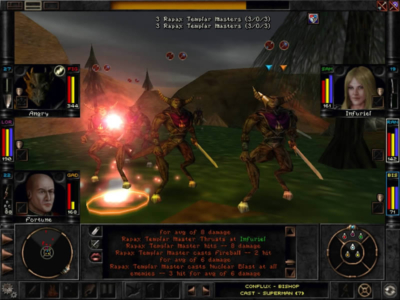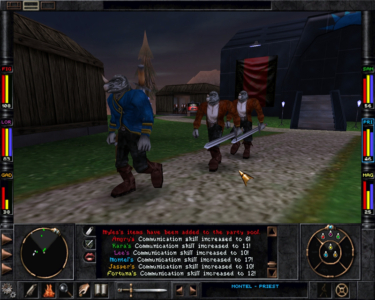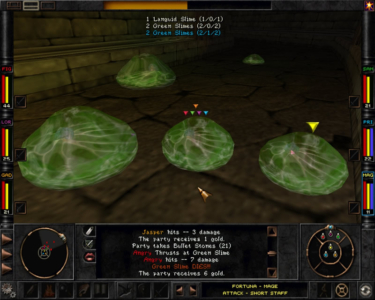
Wizardry 8
Written by: Stoo
Date posted: April 9, 2003
- Genre: RPG
- Developed by: Sir-Tech
- Published by:
- Year released: 2001
- Our score: 8
Okay, so this game isn’t all that ‘old’. However, seeing as I was eagerly awaiting it for many years, I feel I should write down some of my thoughts. The Wizardry series stretches back to the very early days of PC gaming, and up to the early 90s remained a favourite of serious RPG fans. However, it took Sir-Tech nearly a decade to bring us an eighth game, and it had a difficult birth with the developers struggling to find a publishing deal.
If you’re new to as long a running RPG series as this, you might wonder if you’re coming in very late to the show with part 8, or if they’re all separate stories in a Final Fantasy style. Well, actually Wiz8 forms the final part of a trilogy that began in game 6 (Bane of the Cosmic Forge). The second part (ie game 7), is Crusaders of the Dark Savant – reviewed on this site.
Still, newcomers shouldn’t feel alienated as a functional (if not hugely impressive) introductory animation fills you in on the current state of affairs. In short, after a fight between many factions on the backwater little world of Guardia, the evil and awesomely powerful Dark Savant triumphed and took his prize: the Astral Dominae, an ancient artifact that allegedly holds the secret of life itself. With the other factions in hot pursuit, he then travelled to a planet known as Dominus. Here he plans to gather another two powerful artifacts, and use them to grant him access to the Cosmic Circle and usurp the godlike Cosmic Lords, who control the laws and makeup of this universe. Meanwhile, your little band of adventurers from an unimportant primitive world also end up on Dominus, courtesy of one of the races opposing the Dark Savant, and unsurprisingly it’s up to your humble selves to stop the madman from becoming a god himself.
Of course, before you can begin the game, you need to create your band of plucky heroes. This is a much speedier process than it was in the previous game, as you don’t have to sit around for hours doing virtual dice-rolling to create the more elite character classes. Choosing the race and class of each hero, you can quite quickly have your ideal team ready to go. There’s certainly plenty of choices available. For example, Warriors can do more raw damage than any other class, but Samurai are faster and can deal out critical hits (ie instant kills), and Rangers are masters of ranged combat. There are also various kinds of spellcasters; Mages excel at damaging and debilitating enemies, whilst Priests are better for healing and enhancing your own team. For added variety you might want to try Monks (kung-fu experts), Bards (play magically enchanted instruments) or Gadgeteers (create useful items out of bits of mechanical junk). Choosing the right race for each hero helps too; a Lizardman makes a kick-ass fighter but, as he isn’t the brightest of characters he might not be such a great Bishop. Speedy Felpurrs make ideal samurai, though their nimble fingers might mean they’re good for thieving too. Of course, jack-of-all trades humans are reasonable at just about anything, and the old fantasy favourites like dwarves and hobbits are available too.
There are of course masses of skills and stats to play with. This applies both during the creation process and also when “leveling up” after gaining experience points for killing monsters, in the time-honoured RPG manner. For example, as well as a general “close combat” skill, there are then further weapon-specific skills available, depending on the character. While a Warrior or Lord has the full set available, from swords to poleaxes to maces, classes like the Mage might be limited to wimpy staves and slings.
There are various magical proficiencies too, split into six realms: fire, water, earth, air, divine and mental. Add on top of that skills like dual-wielding (for two weapons at once), critical hit (for instant kills), lockpicking, pickpocketing, and more. In other words, there’s a hell of a lot of numbers to play with. If you find this off-putting then, well, odds are you’re not going to like this game, as to make the most of your characters you really do need to think about how you’ll allocate the points available. Note however that characters don’t just improve on a level-up; all skills will gradually improve with practice, so your team very slowly but steadily gain in power with each fight.
A note for Crusaders veterans: you will be pleased to hear that you can of course import your team from that game. Regardless of how powerful they were before, they’re scaled back to level 5 for this new adventure and they lose most of their fancy wargear. Which sounds disappointing at first, but when you think about it a game wouldn’t be very challenging (or fun) if you started with a bunch of level 60 super-warriors.
As a final nice touch, you then assign personalities to each of your heroes. There’s a wide range – kindly, angry, eccentric, intellectual etc. This has no effect on how skilled or powerful they are in game, instead each personality type links to a different set of comments that are voiced by that character when they spot an enemy, enter a new area, note something interesting and so on. This aids the all-important immersion factor, by letting you become a lot more attached to your heroes. Instead of being just a set of monster-killing statistics, they are that little bit more like real people who each react in their own way to the environment around them. Some of the voices are unfortunately pretty annoying – is it really so hard for Americans (or Canadians in this case perhaps) to find actual Europeans for their English or German accents, rather than a terrible voice-actor making some hammy and cringe-inducing attempt? Still, when not trying to sound like a Bavarian barmaid they’re a lot better. I became quite attached to my camp priest, psychotic mage and sarcastic loner Warrior.
Anyway, once character creation is complete you can set foot onto the world of Dominus. Of course, the engine creating this environment is a hell of a lot more advanced than what we saw in the last game. Gone is the flat, tile based world of Guardia; Dominus revels in full 3D. I have to say though that graphically Wiz8 is, while not at all bad, still a bit behind the times. What’s most annoying that the engine only draws the terrain around you out to a relatively short distance and then fades to the background sky. This isn’t really a problem when in, say, a castle when you have walls all around you but in a big open wilderness area it can hurt the effect a bit. For example, you might seem to have flat ground and the night sky in front of you, but walk forwards a few paces and a hill suddenly appears where previously you could see the rising moon. Perhaps this is a sign that the game was in development for too long; it does have a faint “made in 1998” feel to it. Still, this is an RPG and while graphics aren’t irrelevant, they don’t make or break these games.
During peaceful moments, yourselves and any characters or enemies that you meet move in real-time. However, when combat begins, the game flicks to a variant on turn-based combat called ‘phased’. This essentially means that you hand out orders to the team (fight, defend, cast spell etc), then click ‘go’, sit back and watch what happens until the turn ends. There are some oddities, however, due to the engine. You see, though you have up to 8 people in the team, you never actually see any of them (apart from their portraits around the sides of the screen). Instead, you see all the action in the game through a kind of collective first-person view. Your heroes are arranged in a tight little bundle, and though you can alter the formation within that bundle, there’s no way to space them out, or split them up into more than one group. In effect the team always moves and fights like a single, multi-limbed creature.
This can sometimes make combat frustrating; especially out in the open where you can usually expect to be outmanoeuvred and encircled. If the enemies are spaced out, you must leg it from one foe to the next (and if you move in a turn, it restricts how much fighting you can do) rather than engaging several simultaneously, often while spells and arrows are raining amongst you. On the other hand, your “eight in one” existence can be an advantage to fighting in tunnels and narrow spaces, when enemies must come at you one or two at a time, each of whom you can bring your full strength upon. Still, you can’t help feeling there would have been more tactical options if your separate party members were actually rendered and viewable in-engine, and thus also separately moveable.
Stepping back from the carnage for a minute, Wiz8 is story driven in a very general sense, but to be honest you’ll spend more time fighting things than doing anything else. Some of the battles can go on for about half an hour, especially as enemy ranks are sometimes swelled by more monsters stumbling across the fight and deciding have a go themselves. Wading in and hacking at things isn’t always the best option; you might want to hold back so your spellcasters can heal their comrades, or try a freezing spell on the foes, while the gadgeteer tries out his latest contraption and the monk changes position to protect your rear. Note that direct-damage spells like fireballs can sometimes seem a bit underpowered; when spellcasting you’re often better off trying to debilitate your foes (with spells causing sleep, paralysis, insanity etc) so as to make them easier targets for your sword-wielding types. Of course, as this is an old-school RPG beneath it’s 3d-enhanced exterior, there’s much in the way of dice-rolling going on, and numerical profiles to analyse. It does help to pay attention to such details as how characters’ attack ratings vary with different weapons, or the magical resistance scores of your enemies, as they do affect combat performance.

The Rapax are major antagonists. The pop-out portraits mean my guys are probably complaining about something or other.
One more point; to a certain extent Wiz8 seems to scale random monster fights to the level of your own team. Example: your team of level 3 heroes is traveling along a road, when a bunch of level 4 bats and giant insects ambushes you. You kill them with some difficulty. Later on, you’re up to level 6 and passing the same way. You might think that now you now should find the fights here simple, but then realise the monsters fighting you are now level 6 or 7 themselves. This is annoying, and would seem to negate the point of increasing in level. Fortunately this effect doesn’t go on indefinitely, ie in a given area there’s a maximum limit to the level of monsters in a given area, and you will eventually be able to pass through much of Dominus knowing you can crush all foes before you.
When not locked in combat there is a lot of exploring to do and a few missions to carry out. The game isn’t too linear; to a large extent you are free to roam wherever you wish, though you may wish to keep your new party out of some of the really dangerous areas until they’re more experienced and powerful. The world of Wiz8 is quite varied; though in truth it has nothing like the vast majesty of Morrowind, there’s still enough to keep you exploring for a while. There are mountains, swamps and ruins, and each of the main factions controls a town or fortress of some kind. Note that Dominus isn’t just a standard-issue dungeons-and-dragons-esque fantasy world, as some of the races are quite advanced and possess high technology, especially visiting aliens like the Umpani. As for the more primitive natives, you will meet (amongst others) the friendly, furry little tree-dwelling Trynnies, and the warmongering Rapax.
Interactions with Non-player characters can be a useful part of creating a convincing RPG world, and fortunately there are a fair few here to chat with. Indeed you can learn much this way about what you should be doing on Dominus. A few are familiar faces from Crusaders (there’s even one from Bane); good old Rodan Lewarx is back, as is the sinister Don Barlone plus a couple more. A handy interaction system allows you to question people by clicking on suggested keywords, or typing in new ones that you’ve thought of. Some characters will even join your team; apart from bolstering your numbers this can help fill in the ‘gaps’, if for example you think your guys lack a spellcaster. My advice is to take along RFS-81, the kung-fu android.
The voice-acting adds a lot of personality to the characters you meet, for example the Umpani have US Marines style voices which suits their military expedition-force nature perfectly. Meanwhile the villainous Rattkin play the stereotypical New York (or is it New Jersey?) mobster line very well and the Trynnie are just plain lovably enthusiastic. On the other hand, the Dark Savant sounds like a good candidate for the position of cheesiest cartoon villain in the known universe, but I suppose you can’t expect perfection.
So far, so good, examining factors of the game in turn. Still, looking at the game as a whole it does somehow feel a bit more simplistic than its predecessor. There’s not a huge amount of puzzle solving, or any kind of situation requiring much use of the old grey matter, outside of battle tactics. Wizardry seven was itself very combat-heavy also, but still you’d often be traveling far and wide for clues or items useful to progressing in a certain location, or pondering the odd tricky puzzle. Everything in Wiz8 however is pretty self explanatory. Upon entering a new area, your list of things to do normally comes down to just killing monsters and grabbing loot. Also, this isn’t one of those games to give you a stack of specific quests; apart from a few missions for the T’Rang and Umpani, you’re essentially just left to hack, slash and blunder around until you find yourself in a position to grab the three final magic baubles.
At the end of the day, what we have an RPG built around an old-fashioned but decent combat system, but behind the gameplay is a fairly basic and functional storyline, which I’m sure Sir-Tech could have put some more work into. In fact, there is a vaguely unfinished feel to the game as a whole. For example there’s a large cathedral in a wilderness area that really does seem as if it should be the setting for some kind of major story-driven quest, but in fact it has no significance to the story whatsoever and is just the setting for yet another battle with a horde of monsters. Meanwhile a port in a major city hints at the possibility of sea travel and access to further areas of Dominus, but no functionality is attached and it turns out to be just a few decorative bits of scenery. What’s also frustrating is that at certain points in the story some characters promise to team up with you at a later stage, but then completely fail to show up. These examples give the impression that the development process behind Wiz8 was quite rushed towards the end; perhaps a result of the precarious financial situation Sir-Tech found themselves in.
Overall I can’t shake the impression that Wiz8 didn’t quite live up to my hopes, but these were probably inflated beyond realistic levels by long years waiting, and in some regards we should be thankful for the game ever being published in the first place. In many respects it’s soundly beaten by the behemoth that is Morrowind, which offers huge and awesome-looking landscapes and cities, along with a very flexible classes system and multiple factions to work for. However, Bethseda’s offering is an RPG of a slightly different kind, putting you in control of just a single character and featuring real-time action. If you want a go at controlling a party of several characters, or prefer tactical turn-based combat, you may well like Wiz8. It’s probably maybe not a contender for “king of the RPGs”, but it makes a worthy effort of bringing the old Wizardry gameplay to a more modern generation of gaming, and there are many days of solid monster-slaying fare available for those who don’t mind its slightly dated nature.




 Posts
Posts